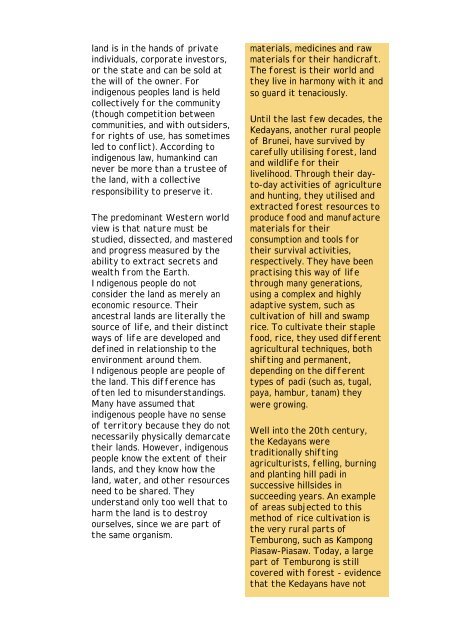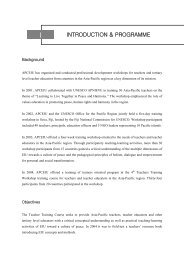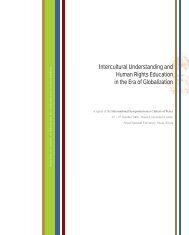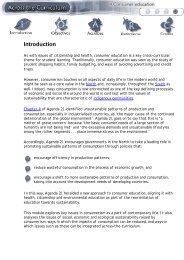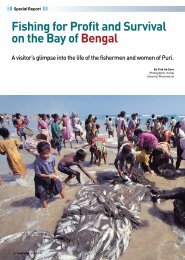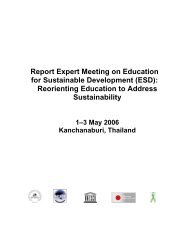Module 11 | Indigenous knowledge and sustainability - APCEIU
Module 11 | Indigenous knowledge and sustainability - APCEIU
Module 11 | Indigenous knowledge and sustainability - APCEIU
You also want an ePaper? Increase the reach of your titles
YUMPU automatically turns print PDFs into web optimized ePapers that Google loves.
l<strong>and</strong> is in the h<strong>and</strong>s of private<br />
individuals, corporate investors,<br />
or the state <strong>and</strong> can be sold at<br />
the will of the owner. For<br />
indigenous peoples l<strong>and</strong> is held<br />
collectively for the community<br />
(though competition between<br />
communities, <strong>and</strong> with outsiders,<br />
for rights of use, has sometimes<br />
led to conflict). According to<br />
indigenous law, humankind can<br />
never be more than a trustee of<br />
the l<strong>and</strong>, with a collective<br />
responsibility to preserve it.<br />
The predominant Western world<br />
view is that nature must be<br />
studied, dissected, <strong>and</strong> mastered<br />
<strong>and</strong> progress measured by the<br />
ability to extract secrets <strong>and</strong><br />
wealth from the Earth.<br />
<strong>Indigenous</strong> people do not<br />
consider the l<strong>and</strong> as merely an<br />
economic resource. Their<br />
ancestral l<strong>and</strong>s are literally the<br />
source of life, <strong>and</strong> their distinct<br />
ways of life are developed <strong>and</strong><br />
defined in relationship to the<br />
environment around them.<br />
<strong>Indigenous</strong> people are people of<br />
the l<strong>and</strong>. This difference has<br />
often led to misunderst<strong>and</strong>ings.<br />
Many have assumed that<br />
indigenous people have no sense<br />
of territory because they do not<br />
necessarily physically demarcate<br />
their l<strong>and</strong>s. However, indigenous<br />
people know the extent of their<br />
l<strong>and</strong>s, <strong>and</strong> they know how the<br />
l<strong>and</strong>, water, <strong>and</strong> other resources<br />
need to be shared. They<br />
underst<strong>and</strong> only too well that to<br />
harm the l<strong>and</strong> is to destroy<br />
ourselves, since we are part of<br />
the same organism.<br />
materials, medicines <strong>and</strong> raw<br />
materials for their h<strong>and</strong>icraft.<br />
The forest is their world <strong>and</strong><br />
they live in harmony with it <strong>and</strong><br />
so guard it tenaciously.<br />
Until the last few decades, the<br />
Kedayans, another rural people<br />
of Brunei, have survived by<br />
carefully utilising forest, l<strong>and</strong><br />
<strong>and</strong> wildlife for their<br />
livelihood. Through their dayto-day<br />
activities of agriculture<br />
<strong>and</strong> hunting, they utilised <strong>and</strong><br />
extracted forest resources to<br />
produce food <strong>and</strong> manufacture<br />
materials for their<br />
consumption <strong>and</strong> tools for<br />
their survival activities,<br />
respectively. They have been<br />
practising this way of life<br />
through many generations,<br />
using a complex <strong>and</strong> highly<br />
adaptive system, such as<br />
cultivation of hill <strong>and</strong> swamp<br />
rice. To cultivate their staple<br />
food, rice, they used different<br />
agricultural techniques, both<br />
shifting <strong>and</strong> permanent,<br />
depending on the different<br />
types of padi (such as, tugal,<br />
paya, hambur, tanam) they<br />
were growing.<br />
Well into the 20th century,<br />
the Kedayans were<br />
traditionally shifting<br />
agriculturists, felling, burning<br />
<strong>and</strong> planting hill padi in<br />
successive hillsides in<br />
succeeding years. An example<br />
of areas subjected to this<br />
method of rice cultivation is<br />
the very rural parts of<br />
Temburong, such as Kampong<br />
Piasaw-Piasaw. Today, a large<br />
part of Temburong is still<br />
covered with forest - evidence<br />
that the Kedayans have not


